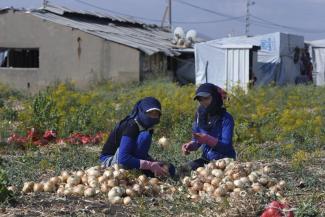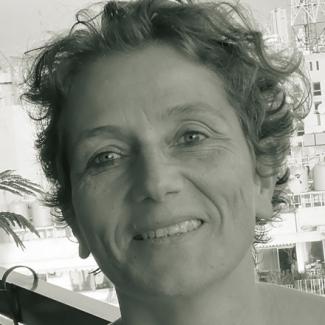Refugees
Lebanon needs help
 Hussein/AP/picture-alliance
Syrian refugees often work as harvesters in the Bekaa Valley: women collecting onions.
Hussein/AP/picture-alliance
Syrian refugees often work as harvesters in the Bekaa Valley: women collecting onions.
Deir El-Ahmar is a village in the Lebanon Mountains, which range from the north to the southwest of the country. The hillside offers a breathtaking view of the Bekaa Valley and the mountain rage which forms the border to Syria. Outside the village are Syrian refugee camps with huts made of lightweight wooden frames and plastic sheeting. In recent years, more and more of these hut settlements have spread throughout the Bekaa Valley. Eastern Lebanon is the first stop for many Syrian refugees. According to the UN Refugee Agency (UNHCR), more than 400,000 people have settled in the Bekaa Valley after fleeing the war in their home country. They make up about a third of all the Syrian refugees the UNHCR has registered in Lebanon.
Deir El-Ahmar has 27,000 residents and 4,000 refugees. One of the first things a visitor notices when entering the village are the many signs of international agencies, including the EU, UNHCR, UNDP, Caritas and USAID.
Like most of Deir El-Ahmar’s residents, Subhi Khoury is a farmer. He grows onions, potatoes, lentils and apples. Farming in this area would be unthinkable without Syrian labourers. “There are Syrians who have worked for me for 20 years. Normally they return home after the harvest. Now they live here all year, and their families have joined them,” Khoury reports.
These additional people do not just mean more workers for the community. They also place a significant burden on the village’s already-weak infrastructure. “We have problems with garbage removal and power supply,” Khoury reports. “Our administrative costs are rising.”
The 70-year-old farmer is the director of the association of cooperatives in Deir El-Ahmar and the surrounding area. Even before the influx of Syrian refugees, Khoury’s association cooperated with the international agencies, the signs of which now cluster around the village entrance.
In joint action, irrigation systems were expanded and cold storage rooms built. As the number of refugees rose, projects were added that directly benefit the farmers of Deir El-Ahmar. “The UNDP financed
a packaging facility for apples, and the UNHCR donated thousands of grapevines,” Khoury says.
Inadequate food aid
Issa Badr and his family live in a hut outside Deir El-Ahmar. They are from the environs of Aleppo in northern Syria. Back home, Badr worked in a factory. In Lebanon, he earns his living in agriculture and construction.
Daily wages are modest for Syrian workers in the Bekaa Valley. Working in the fields, Badr earns 15,000 Lebanese pounds a day (about € 7.50). Women receive a third less. Wages in construction are somewhat better at 30,000 Lebanese pounds a day.
Badr says that he gets along fine as long as he has work. Only by earning money can Syrian families make ends meet. Refugees would barely survive on the food aid they get from the UNHCR.
Badr says that relations are good between the refugees and the residents of Deir El-Ahmar. Khoury agrees, but adds: “We won’t let Syrians take jobs away from us. It isn’t easy for Syrians to open restaurants or shops here.” In a joint report published at the end of 2014, the UNHCR, UNDP and the Lebanese Ministry of Social Affairs detected considerable tensions between refugees and host communities. According to the authors, relations are strained because people compete for services and resources. They argued that violence may be rare, but can erupt any time. The report concluded that the solution is to strengthen Lebanese host communities.
The UNHCR, for example, is helping Lebanese communities by overhauling schools, hospitals and sports fields and by implementing measures to support farmers, as in the case of Deir El-Ahmar. This year, the agency is dedicating 30 % of its budget for the Syrian refugee crisis in Lebanon to such projects.
Dana Sleiman, who works for the UNHCR in Beirut, explains why these efforts are so important. Lebanon, with its population of 4 million, had to take in more than a million additional people over the past few years: “That’s like the United States taking in 75 million.” According to Sleiman, most of the refugees have settled in northern and eastern Lebanon – poor regions that already needed economic assistance.
The UNDP funded the latest project by Deir El-Ahmar’s village cooperative: a water basin that serves to collect the snowmelt and rainwater that comes down from the mountains. “The basin will give us enough water to irrigate all vines and fruit trees of our cooperative twice a year,” says Khoury. “We are pleased. The Lebanese government is doing nothing to help us, but these measures benefit us and the Syrians who live here with us.”
But people’s experiences are not so positive elsewhere. Baalbek, a quiet provincial town about 20 kilometres east of Deir El-Ahmar, took in roughly 20,000 refugees in addition to its 100,000 residents. The border is close, and people have relatives on both sides. During Hezbollah’s war against Israel in 2006, many Lebanese fled to Syria. Nevertheless, Lebanese residents of Baalbek are likely to express displeasure when asked about the Syrians who have settled in their city.
Shahnaz Osman, a student from Baalbek, says what is on many residents’ minds: “They are taking our jobs. We have even less electric power and water than before. And housing is becoming more expensive.”
According to Osman, moreover, many people resent the fact that Syrians are marrying Lebanese women. She reports that in her part of the city, fights have broken out between Syrian and Lebanese neighbours over minor issues like complaints about night-time noise.
Yahya Khalaf, a Syrian who moved to Baalbek from his hometown near Aleppo, has encountered his share of problems. The sports-teacher-turned-housepainter is always being pressured by his Lebanese clients to lower his prices, but he feels shunned by his Lebanese neighbours.
Neither Osman nor Khalaf are content to live with tensions of this kind. Therefore both the Lebanese student and the Syrian housepainter have decided to join the “Communication Support” programme that is run by the Lebanese Organisation for Studies and Training (LOST) (see box). They know the refugees are unlikely to return home any time soon, so peaceful coexistence is the only option.
Mona Naggar is a journalist and media trainer. She lives in Beirut.
mona.naggar@googlemail.com
Link:
UNHCR: Data about Syrian refugees.
http://data.unhcr.org/syrianrefugees/regional.php


